Alaska Fish & Wildlife News
December 2022
Darren Bruning: Wildlife Professional of the Year
Working for Wildlife from Nebraska to Alaska
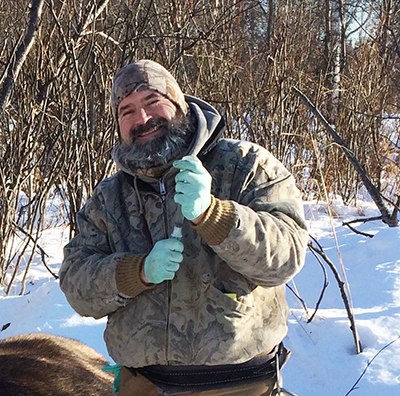
Darren Bruning, a biologist with the Alaska Department of Fish and Game, has been named Wildlife Professional of the Year by the Western Association of Fish and Wildlife Agencies.
The award recognizes a wildlife professional who has made the greatest contribution to the management, protection or enhancement of fish and wildlife resources. For Bruning, it encompasses a career of contributions in all three categories. From Nebraska to Alaska, his work with bison, deer and elk, river otters and bighorn sheep, with wildlife health and wildlife habitat, and with the people connected to the animals and the land – has been acknowledged by his peers.
Bruning was honored at the professional association’s 100th anniversary meeting this summer in Oklahoma City.
“My whole career I worked amongst giants in this profession, people I’ve looked up to,” Bruning said. “I was able to give thanks to so many people I’ve worked with over the years. My career has been in the footprint of the Western Association.”
Bruning’s career chapters include his family’s home state of Nebraska, as well as North Dakota, Eastern Oregon and New Mexico, with many overlapping projects, but bison are a through-line. Bison brought him to Alaska in 2011 as the area biologist in Delta Junction, home to the largest plains bison herd in the state and one of the few wild bison populations in the world. He also worked on the restoration of wood bison to Alaska, the only wood bison herd in the United States.
“Literally my whole life I idealized bison as a missing piece of my world,” he said. “They were an overwhelming force and presence on the North American continent, and that always resonated with me. If I’d have thought that I could’ve been a ‘bison biologist’ I would have been one. I had dreams and visions of bison in the Nebraska sandhills and Oglala grasslands. But in the 1980s and ‘90s, the view was, ‘their time is over.’ Hardly any state recognized them as a wildlife species, they were seen more as non-traditional livestock.”
Where the Buffalo Roamed
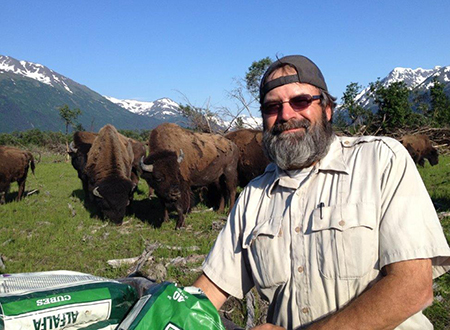
Bruning grew up on a family farm on the grasslands of south-central Nebraska, fascinated with wildlife of the prairie. As a boy, he was amazed to learn that a wetlands near his farm was an old “buffalo” wallow. “I lived where the buffalo lived! I couldn’t believe it. This was an important connection for me. In addition, relatives told me many times, and pointed out where the last bison in my county was killed – about 150 feet from my bedroom window.”
Bruning devoured the family’s set of World Book Encyclopedias, and all the books about animals he could find. Teenage years and early 20s included farm work, doctoring cattle in Texas, and honing his outdoor “mountain man” skills, including building a .50 caliber muzzle-loader from a kit. He loved music and was a serious drummer. Before he became a wildlife biologist, he spent much of the 1980s playing his drums in rock bands in Dallas and gigging across North Texas.
In the late 1980s, Bruning was working at a huge cattle feed lot in the Texas panhandle with a veterinarian who encouraged him to go to vet school. Bruning told him he was more interested in a job, “where you collected elk urine.” “You need to study wildlife biology at Colorado State University,” the vet told him. It was excellent advice.
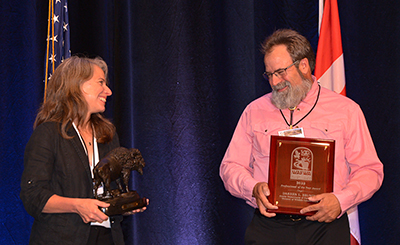
Richard Nelson, the ADF&G wildlife management coordinator for Southeast Alaska, nominated Bruning for the award. He met Bruning 33 years ago when he hired him as a seasonal technician with Nebraska Game and Parks Commission, while Bruning was in college at CSU in Fort Collins.
“I recruited the best and brightest wildlife students out of regional universities,” Nelson said. “I called the school and said, ‘I need someone with a diverse set of skills to do some real wildlife work in Nebraska. Who do you have?”
Nelson became a mentor to Bruning, and helped him move from seasonal tech to his first full-time position, in Nebraska. “He completely taught me most or all of what I know about state agency wildlife management,” Bruning said.
Nelson said Bruning’s talent as a wildlife generalist and problem solver is remarkable. “He‘s probably by far the best naturalist you’ll ever know,” he said. “He’s had a series of accomplishments in his career, and wildlife restoration is one theme that runs through it.”
Restoring wildlife
Bruning helped restore bighorn sheep, river otters and bison to former ranges, including wood bison, the largest land mammal in North America. In keeping with his skills as a generalist, this work was often done as Bruning managed other responsibilities. He was working in wildlife health surveillance when he “shoehorned in” river otter restoration, bringing 36 river otters from Washington state to the upper Rio Grande River in the Sangre de Cristo Mountains of New Mexico in the early 2000s.
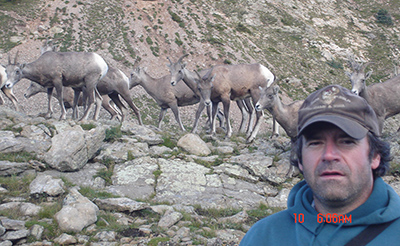
“I’d live trap them and transport them to a facility where I could take care of them,” he said. “Do health surveillance and take care of all the bureaucracy and administration to bring them from one state to another.” (This included Bruning driving otters close to 1,500 miles south.) “Then on the New Mexico end, the soft release could take three to five days, making sure they were acclimated, healthy and uninjured and gaining some familiarity with their new environment.”
At the time, Bruning was based in Olympia, Washington, working with the USDA National Wildlife Disease Program, work that was taking him across the country. He was looking into diseases like avian influenza in waterfowl, tularemia in small and mid-size mammals, respiratory illnesses in bighorn sheep, and bovine tuberculosis and chronic wasting disease in deer and elk.
“I recognized early on that the health of these wild populations was very important, and learning more about it, I realized that it was somewhat of an overlooked aspect of wildlife management,” he said. “It was always some part of other jobs, and it got to the point where I made it an emphasis.”
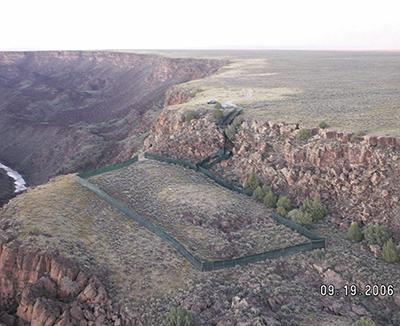
Wearing multiple hats helped – and gave him connections to projects that needed some glue to bind diverse groups together, groups that shared a common goal but sometimes didn’t realize this and also struggled to advance it. “All these people really wanted river otters back in New Mexico,” Bruning said. “Defenders of Wildlife, the Taos Pueblo Tribe, New Mexico Game and Fish Department, private citizens groups, and the BLM. They hadn’t been able to move forward separately. I started connecting them.”
Bruning also helped restore bighorn sheep to that same area – historic low-elevation range in northern New Mexico. A major focus for Bruning was the soft-release of the animals, a thoughtful, gradual release at the new location that minimized stress and mortality. He knew in past reintroductions, bighorn sheep had been chased, captured, processed, transported down bumpy backroads and then essentially shooed out of the stock truck, only to flee for their lives in a panic across dangerous terrain. This often infamously resulting in, “That’s not what we wanted them to do and that’s not where we wanted them to be.” The approach of his team was to construct a one-acre holding pen at the release site in advance, allow the animals to unload themselves from the trailers and acclimate for days in the enclosure, and then filter out an open gate into the Rio Grande Gorge.
The spring following the release of the 23 bighorns, 14 of the 16 ewes lambed. Within a few years the population had grown to more than 100 animals. It is now one of the largest Rocky Mountain bighorn populations in New Mexico. In addition to the Rio Grande Gorge population, in later years, Bruning also assisted with the reintroduction of bighorn sheep to the Rocky Boy Reservation in north central Montana.
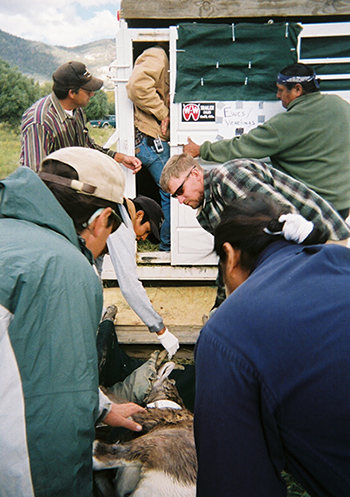
He spent several years in New Mexico, working with the Taos Pueblo’s herd of bison, and helped create the tribe’s game and fish department.
Problem Solving
Early in his career, Bruning realized that working with people is a huge part of being a wildlife professional. Being the right person “with a diverse set of skills to do some real wildlife work” led to his first full-time wildlife job, working with landowners in Eastern Nebraska creating, enhancing, and protecting range, woodlands and wetlands as wildlife habitat. In addition to being a habitat biologist he was also assistant to the wildlife division’s director and, “wrote a lot of letters and was eyebrow deep in federal aid.”
After Bruning had been several years in Nebraska, Nelson received a call from the Director of the North Dakota Game and Fish Department with a request: “I’ve got some messes on the Missouri River – do you have anyone who can help me solve these problems?” Nelson faxed Bruning an announcement for a job as a district biologist in North Dakota, a true hook and bullet state, Bruning said. He was hired.
There were two major issues at hand there, one caused by white-tailed deer and the other by people.
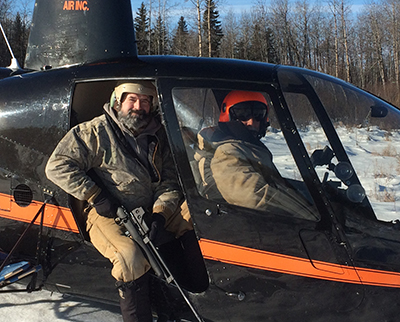
“There were tremendous numbers of white-tailed deer, and deer depredation was a huge problem – deer eating farmer’s hay. I learned one of the important roles of state wildlife agencies is being accessible to people. If someone called, we picked up the phone. If they came in, we talked. It was bitter cold, hard to keep a farm running, the tractor won’t start, and there’s 150 deer out there eating the hay. We showed up. You can’t always fix everything, but if you try, they become supporters for wildlife conservation and management. You help someone save the rest of their hay when it’s 22 below zero and they’ll back you up and listen to you. You buy credibility.”
No doubt that helped with the other issue, egregious abuse of public land. People were fencing public land, posting it as private, building boat ramps and intimidating others from using them, diverting water, mowing wild grasslands for hay, illegally grazing livestock, putting up trailers and sheds, and quarrying soil and rocks. There were gross violations of crop share agreements, boundary violations and land grabs.
“We systematically addressed the problems without alienating people,” Bruning said. “I don’t know if I could do it today. How did I jump from rock-to-rock without a misstep? My greatest satisfaction in North Dakota was ensuring that public wildlife lands were there to be wildlife habitat. And somehow we did it without making enemies out of those people.”
The Great Grant County Lion Wars
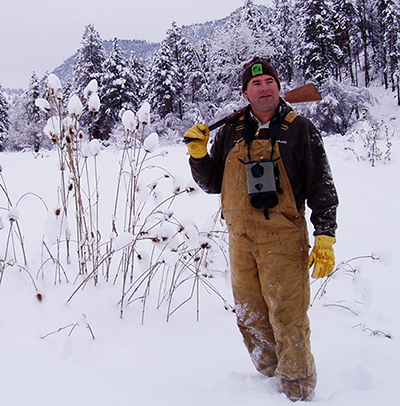
Bruning left North Dakota for the ponderosa-pine forested canyons of Eastern Oregon – which Bruning calls a wildlife paradise. As a district biologist there, he captured bighorn sheep and mountain goats, and counted a lot of elk. He dove into wildlife health surveillance and a variety of other work, but day in and day out, the topic he dealt with most was mountain lions – and the very vocal, impassioned and lion-intolerant public.
“Every missing dog, cat, hamster and chicken had been eaten by a mountain lion. Every cow or horse that had a cut, abrasion, limp, or just looked scared had been attacked by a mountain lion. Every sheep killed by a dog was killed by a mountain lion. I called it ‘The Great Grant County Lion Wars.’”
In 2005, after five years, the opportunity to restore bighorn sheep in New Mexico lured him out the lion-infested wildlife paradise. In 2008 he began co-instructing a wildlife capture and handling course at Oregon State University, and still does. Around that same time he made his first trip to Alaska to capture harlequin and Barrow’s goldeneye ducks (and survey marine mammals and sea birds) in the Kodiak National Wildlife Refuge.
Bruning said over the years, he checked for job postings in Alaska, just in case something came up. One night, in 2011, it did – in Delta Junction in Interior Alaska. He described seeing the job opening, “I couldn’t believe my eyes. I looked at it over and over. Being a lifelong student of our national mammal, bison, I knew quite a bit about Delta bison. A truly once in a lifetime chance to be a wild bison biologist!”
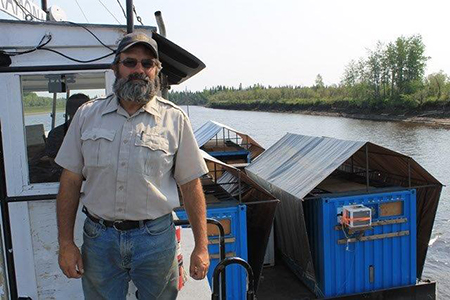
Bruning was hired and worked with the Delta Bison herd, and ever the multi-tasker, soon became involved with the two-decades-long effort to reintroduce wood bison to the Lower Innoko-Yukon River region of southwest Alaska. About 150 wood bison from Canada had been staged at the Alaska Wildlife Conservation Center near Girdwood in preparation for release.
“I essentially moved to the Alaska Wildlife Conservation Center in December of 2014 and stayed there until we finished moving the bison in June 2015,” he said. “We moved the cows and juveniles in March (by air) and bulls in May and June (two trips by barge). I was working with a drug to make their transport safer. Fine tuning the dosage of a calming agent for wood bison.”
Loading and shipping 130 animals that can weigh close to a ton apiece requires calmness. Bruning kept a close eye on the bison as they were loaded into the C-130 cargo plane and also afloat with the bison in custom containers on a barge. “The drug is not a sedative or tranquilizer, and doesn’t affect their motor skills, but it takes away anxiety,” he said. “And we had no injury or loss on the whole transport.”
Bruning went on to serve as the Division of Wildlife Conservation supervisor for Interior and Eastern Arctic Alaska, Region 3, the largest of Alaska’s five management regions. Richard Nelson, his longtime friend and mentor, noted that wrangling that responsibility may be his biggest accomplishment.
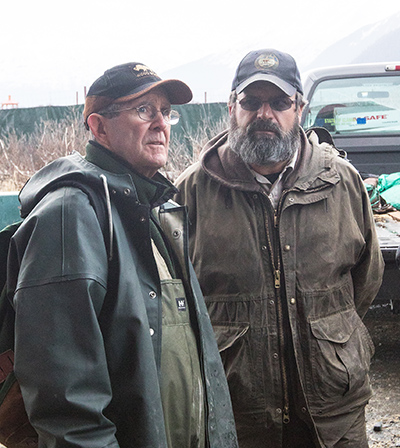
The region is huge, with an international border, high profile federal lands such as Denali National Park and the Arctic National Wildlife refuge, a military presence, remote wilderness, bush communities, oil/gas exploration and development, mining, the Delta Bison Range, an indoor shooting range, high profile/high demand hunts, a photocensus nerve center, Intensive Management, prescribed fire/habitat management, a large aviation program, and federal subsistence issues. There is peer-lauded and award-winning research (and management) on moose, caribou, Dall’s sheep, musk ox, bison, large carnivores, small game, and furbearers.
It was also an opportunity to advance wood bison restoration. In 2022, that happened, as 40 additional wood bison from Canada were brought to Fairbanks to eventually join the Lower Innoko-Yukon River wood bison herd.
Bruning helped move 28 of those bison in the summer of 2022. After transport by truck to Nenana from Fairbanks, he (and McGrath-based biologist Josh Peirce) cared for and monitored them for three days as they floated 800 miles down the Tanana to the Yukon, and then to the Innoko River. Skilled at the soft-release phase of restoration, Bruning worked with Tom Seaton, Luke Rogers and crew to introduce the bison to their herd and their new home. Bison are regaining their place in the wild, Bruning said, something our society has used as a symbol of nature regaining its status as valuable wildlife species. And Alaska is at the forefront.
Subscribe to be notified about new issues
Receive a monthly notice about new issues and articles.
